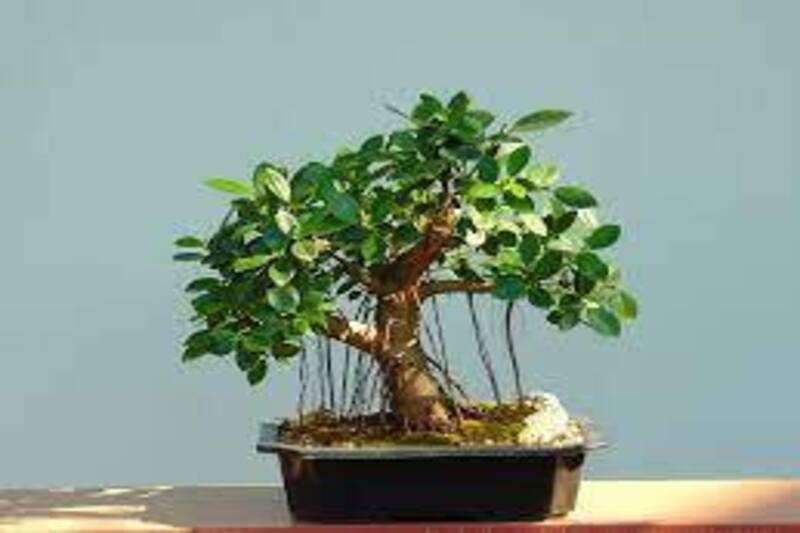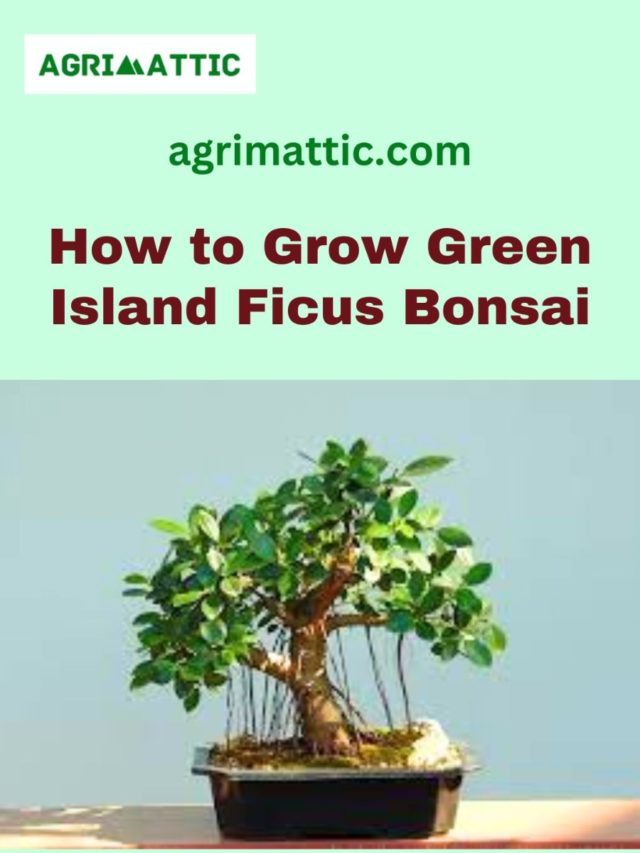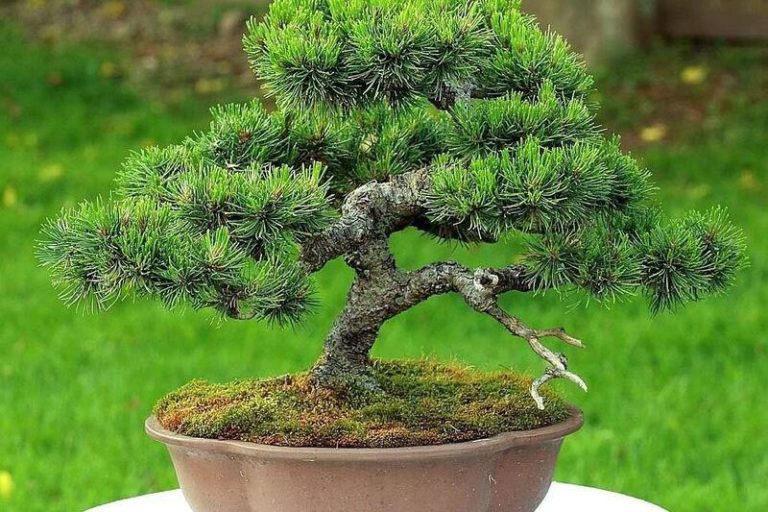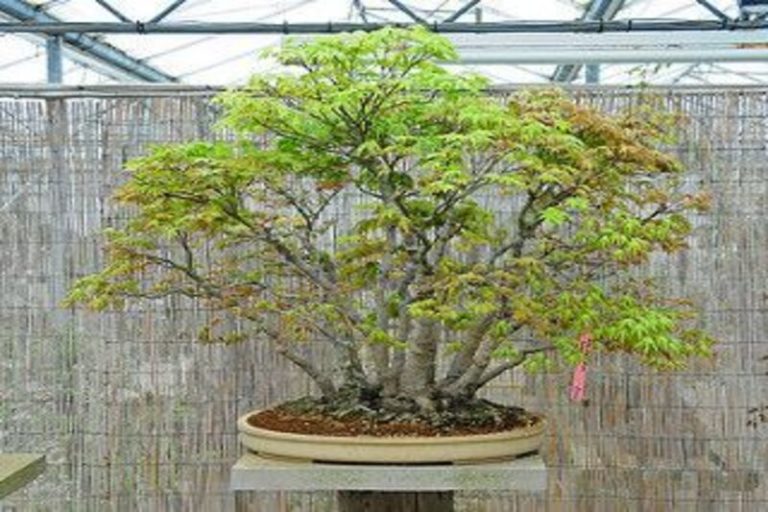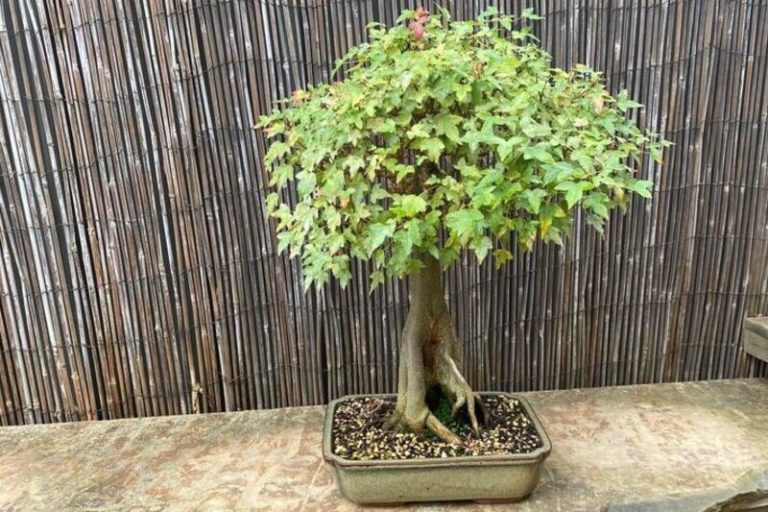Green Island Ficus Bonsai: A Timeless Beauty for Bonsai Enthusiasts
Have you ever heard of bonsai trees? They are tiny, artistic versions of regular trees that are grown in small pots. One popular bonsai tree species is the Green Island Ficus. In this article, we will explore the world of Green Island Ficus bonsai and learn how to take care of these beautiful miniature trees.
What is a Green Island Ficus Bonsai?
The Green Island Ficus Bonsai is a type of bonsai tree that is known for its small, shiny leaves and dense growth. It’s easy to take care of and can be taught to look like different types of bonsai. The tree can grow in both indoor and outdoor settings. It needs to be pruned and watered regularly, and the dirt needs to be able to drain well. Green Island Ficus Bonsai is popular because it has pretty leaves and can grow high roots. It is a popular choice for bonsai fans because it is easy to work with and can be used in many different ways.
History and Origins of the Green Island Ficus Bonsai
The Green Island Ficus Bonsai, also known as Ficus microcarpa, has a rich history and fascinating origins. This bonsai tree species is native to Southeast Asia, including regions like China, Malaysia, Taiwan, and Indonesia.
Ficus microcarpa has been cherished in Asian cultures for centuries, and its use in bonsai cultivation dates back to ancient times. Its small, glossy leaves and compact growth habit make it an ideal candidate for creating miniature trees in the art of bonsai.
The Ficus genus itself is vast, comprising hundreds of species, and Ficus microcarpa is one of the most widely cultivated varieties. It is also commonly referred to as the Chinese Banyan or Indian Laurel due to its close resemblance to these tree species.
Over time, Ficus microcarpa became famous among bonsai fans all over the world, and people started growing it in places other than where it was originally from. It caught the attention of bonsai artists and fans because it was easy to care for, flexible, and beautiful.
Today, the Green Island Ficus Bonsai is cherished for its versatility, as it can be shaped into various bonsai styles, including formal upright, informal upright, and cascade. Its vibrant green foliage and intricate aerial root formations add to its allure and make it a sought-after choice for bonsai enthusiasts.
Through the art of bonsai, the Green Island Ficus has transcended its natural habitat and become a cherished miniature representation of nature’s beauty, connecting people from different cultures and backgrounds in their appreciation for this captivating bonsai tree.
Types of Green Island Ficus Bonsai
There are several types and varieties of Green Island Ficus Bonsai, each with its own unique characteristics. Here are some popular types of Green Island Ficus Bonsai:
Green Island Ficus (Ficus microcarpa ‘Green Island’): This type of Green Island Ficus Bonsai is the most popular and widely grown one. It has small, shiny leaves and grows in a tight clump. It is known for being flexible and easy to take care of, so both new and expert bonsai fans can enjoy it.
Tiger Bark Ficus (Ficus microcarpa, ‘Tiger Bark’): This variety is characterized by its distinctive bark pattern, which resembles the stripes of a tiger. The bark develops a rugged and textured appearance over time, adding to the tree’s aesthetic appeal. Tiger Bark Ficus Bonsai is highly sought after for its unique bark feature.
Golden Gate Ficus (Ficus microcarpa ‘Golden Gate’): This variety is named for its vibrant yellow-green leaves, which provide a striking contrast against the darker bark. The leaves can vary in color, ranging from light yellow to deep green, giving the tree a visually appealing appearance.
Ginseng Ficus (Ficus microcarpa ‘Ginseng’): This type of Green Island Ficus Bonsai is characterized by its thick, bulbous trunk, which resembles the shape of the ginseng root. The bulbous trunk adds a distinctive and unique element to the overall bonsai design, making it a favorite among bonsai enthusiasts.
Willow Leaf Ficus (Ficus nerifolia or Ficus salicifolia): Although not technically a Green Island Ficus, the Willow Leaf Ficus is a closely related species often included in the Green Island Ficus Bonsai category. It is known for its long, narrow leaves that resemble willow leaves, hence the name. Willow Leaf Ficus Bonsai offers a delicate and graceful aesthetic.
These are just a few examples of the types of Green Island Ficus Bonsai available. Each variety offers its own charm and unique characteristics, allowing bonsai enthusiasts to explore different styles and designs while cultivating these captivating miniature trees.

Green Island Ficus Bonsai and its Symbolism
Green Island Ficus Bonsai holds symbolism and meaning that resonates with many people. Here are some common symbolic associations attributed to the Green Island Ficus Bonsai:
- Endurance and Resilience: The Green Island Ficus Bonsai is renowned for its capacity to adapt to many environments and flourish there. It stands for tenacity, power, and the capacity to withstand trying conditions. It serves as a reminder that one may find the inner power to endure even in the face of difficulty.
- Balance and Harmony: The art of bonsai emphasizes balance and harmony in the design and arrangement of the tree. The Green Island Ficus Bonsai, with its carefully styled branches and foliage, embodies the concept of balance in nature. It symbolizes the importance of finding equilibrium and harmony in life, both externally and internally.
- Connection to Nature: Bonsai in general, including Green Island Ficus Bonsai, serves as a connection to nature in miniature form. It reminds us of the beauty and serenity found in the natural world. Green Island Ficus Bonsai can evoke a sense of peace, grounding, and a deeper appreciation for the wonders of nature.
- Patience and Time: The art of cultivating and shaping a Green Island Ficus Bonsai requires patience and time. It symbolizes the value of patience, as the tree gradually develops and matures over the years. Green Island Ficus Bonsai encourages us to embrace the journey, reminding us that growth and transformation take time.
- Miniaturization of Life: Green Island Ficus Bonsai represents the concept of capturing the essence of a full-sized tree within a small, confined space. This miniature representation symbolizes the beauty and wonder of life’s intricacies and complexities. It reminds us to appreciate the small details and find beauty in simplicity.
These symbolic associations are not only meaningful within the world of bonsai but can also resonate with individuals in their personal journeys and perspectives on life. The Green Island Ficus Bonsai serves as a tangible representation of these symbolic meanings, offering a source of inspiration, reflection, and connection to the natural world.
Characteristics of the Green Island Ficus Bonsai
The Green Island Ficus Bonsai, also known as Ficus microcarpa, possesses several distinct characteristics that contribute to its appeal as a bonsai tree. Here are some key characteristics of the Green Island Ficus Bonsai:
Small Size: Green Island Ficus Bonsai is well-suited for bonsai gardening due to its small size. It is normally 6 to 12 inches (15 to 30 cm) tall, making it perfect for inside display or modest outdoor settings.
Glossy Leaves: The Green Island Ficus Bonsai showcases small, shiny leaves that add to its visual charm. The leaves are typically dark green, but they can exhibit variations in color, ranging from lighter shades to deeper hues, depending on the specific variety.
Aerial Roots: One distinctive characteristic of the Green Island Ficus Bonsai is its ability to develop aerial roots. These roots grow from the branches and create an interesting visual element, adding a sense of maturity and complexity to the overall bonsai design.
Dense Foliage: Green Island Ficus Bonsai possesses dense foliage, with leaves growing close together along the branches. This characteristic contributes to the tree’s lush appearance, providing a fullness that is desirable in bonsai aesthetics.
Trunk Texture: As the Green Island Ficus Bonsai matures, the trunk develops an intriguing texture. It may exhibit natural fissures, ridges, or a slightly gnarled appearance, adding character and visual interest to the bonsai tree.
Tolerance to Pruning and Wiring: This variety of Ficus is highly amenable to pruning and wiring, allowing bonsai enthusiasts to shape and design the tree according to their desired style. The branches are flexible and respond well to wiring techniques, making it easier to achieve the desired bonsai form.
Indoor and Outdoor Adaptability: Green Island Ficus Bonsai can thrive both indoors and outdoors, depending on the climate. It can tolerate a range of temperatures and lighting conditions, although it prefers bright, indirect light for optimal growth.
These characteristics make the Green Island Ficus Bonsai a popular choice among bonsai enthusiasts. Its small size, glossy leaves, aerial roots, and adaptability contribute to its visual appeal, while its response to pruning and wiring techniques allows for creative expression in bonsai design.
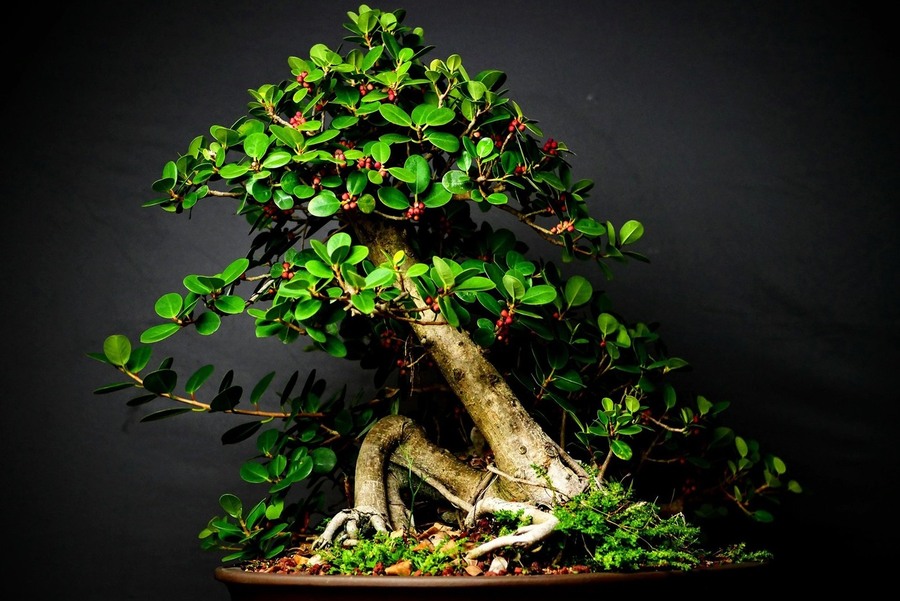
How to Grow Green Island Ficus Bonsai
Growing a Green Island Ficus Bonsai can be a rewarding and enjoyable experience. Here are some essential steps and tips to help you successfully cultivate and care for your Green Island Ficus Bonsai:
- Choosing the Right Tree: Select a healthy Green Island Ficus plant from a reputable nursery or bonsai supplier. Look for a specimen with vibrant leaves, well-developed branches, and a sturdy trunk.
- Potting and Soil: Use a well-draining bonsai soil mix to ensure proper drainage. A mixture of akadama, pumice, and lava rock or perlite works well. Repot your Green Island Ficus Bonsai every two to three years during the spring as it grows and outgrows its current pot.
- Light Requirements: Bonsai Green Island Ficus flourishes in indirect, strong light. Place your bonsai near a window that receives ample sunlight, but avoid prolonged exposure to direct sunlight, which can discolor the foliage.
- Watering: Bright, indirect light is ideal for Green Island Ficus bonsai. Place your bonsai near a window that receives ample sunlight, but avoid direct sunlight for extended periods as it can discolor the foliage.
- Humidity: Green Island Ficus Bonsai appreciates moderate to high humidity. Mist the leaves regularly with a spray bottle to increase humidity levels, especially during dry periods or when the indoor environment is dry.
- Fertilization: Feed your Green Island Ficus Bonsai with a balanced bonsai fertilizer during the growing season (spring to autumn). Follow the manufacturer’s instructions for application rates. Reduce or stop fertilization during the winter months, when growth slows down.
- Pruning and Training: Regular pruning is essential to maintaining the shape and size of your bonsai. Trim back new growth to maintain the overall form and encourage ramification. Use bonsai wire to shape and train branches gently. Be careful not to wire too tightly to avoid damaging the bark.
- Pests and Diseases: Monitor your Green Island Ficus Bonsai for common pests such as aphids, scale insects, or spider mites. If you notice any signs of infestation, treat them promptly with organic insecticides or horticultural oils. Avoid overwatering to prevent fungal diseases.
- Winter Care: The Green Island Ficus Bonsai can tolerate cooler temperatures, but it is best to protect it from frost. If kept outdoors, move the bonsai indoors or provide adequate protection during the winter months.
- Regular Care and Observation: Take time to observe your Green Island Ficus Bonsai regularly. Check for signs of stress, such as yellowing leaves or wilting, and address any issues promptly. Adjust your care routine as needed based on the tree’s response and the changing seasons.
Remember, growing a bonsai tree is a patient and ongoing process. Enjoy the journey and take pleasure in watching your Green Island Ficus Bonsai thrive and develop into a beautiful miniature tree over time.
Benefits of the Green Island Ficus Bonsai
The Green Island Ficus Bonsai offers numerous benefits that make it a popular choice among bonsai enthusiasts. Here are some key benefits of cultivating a Green Island Ficus Bonsai:
Aesthetic Appeal: The Green Island Ficus Bonsai is visually appealing with its small, glossy leaves and compact growth habit. Its lush foliage and intricate branch structure make it a captivating miniature tree that adds beauty and charm to any indoor or outdoor space.
Stress Relief and Relaxation: Caring for a Green Island Ficus Bonsai can be a therapeutic and calming activity. Engaging with nature and tending to your bonsai can reduce stress levels, promote relaxation, and provide a sense of mindfulness and tranquility.
Indoor Decoration: Green Island Ficus Bonsai is suitable for domestic cultivation, allowing you to introduce a touch of nature into your home or workplace. It functions as a distinctive and visually appealing ornament that enhances the ambiance of any room.
Compact Size: Green Island Ficus Bonsai is appropriate for those with limited space due to its diminutive size. Whether you reside in an apartment, have a small garden, or wish to decorate your desk, this bonsai tree can fit precisely into a variety of tiny settings.
Therapeutic Hobby: Growing and sculpting a Green Island Ficus Bonsai can be a satisfying and rewarding pastime. It allows for creative self-expression and allows you to practice perseverance, concentration, and attention to detail. Moreover, it provides a sense of accomplishment as you observe the tree’s growth and development.
Indoor Air Purification: Like many other houseplants, Green Island Ficus Bonsai contributes to indoor air purification. It helps to filter and cleanse the air by absorbing harmful pollutants and releasing oxygen, promoting a healthier and more refreshing indoor environment.
Educational Value: Bonsai cultivation of a Green Island Ficus offers the chance to learn about plant maintenance, horticulture, and the art of bonsai. It enables you to learn about tree species, pruning techniques, and the natural balance, thereby enhancing your understanding and appreciation of the natural world.
Longevity: With proper care, Green Island Ficus Bonsai can live for many years, becoming a long-term companion and source of enjoyment. The longevity of this bonsai tree allows you to develop a deep connection with your living art piece, nurturing it over time.
These benefits make the Green Island Ficus Bonsai a beloved choice among bonsai enthusiasts and plant lovers. Whether you are a beginner or an experienced bonsai hobbyist, cultivating a Green Island Ficus Bonsai can bring beauty, relaxation, and a deeper connection to nature into your life.
Styling and Design of the Green Island Ficus Bonsai
The styling and design of a Green Island Ficus Bonsai offer endless creative possibilities. Here are some common styling techniques and design options for shaping your Green Island Ficus Bonsai:
Formal Upright (Chokkan): This classic bonsai style features a straight, upright trunk with gradually tapering branches. The Green Island Ficus Bonsai can be trained into a formal upright style by carefully selecting and pruning the branches to create a balanced and symmetrical appearance.
Informal Upright (Moyogi): The informal upright style allows for a more natural and organic look. The trunk of the Green Island Ficus Bonsai is slightly curved or slanted, mimicking the growth patterns of a mature tree in nature. The branches are arranged in a less uniform manner, creating a sense of movement and asymmetry.
Cascade (Kengai): Cascade style involves training the trunk of the Green Island Ficus Bonsai to cascade down below the pot’s rim, resembling a tree growing on a steep slope or cliff. By choosing appropriate branches for the cascading effect and using wiring techniques to direct the trunk’s growth, one can achieve the effect.
Windswept (Fukinagashi): This style captures the appearance of a tree shaped by strong winds. The trunk of the Green Island Ficus Bonsai is slanted or bent to one side, and the branches are arranged to depict the wind’s influence. Wiring and careful pruning are employed to achieve the desired windswept look.
Multi-Trunk (Ikadabuki): The Green Island Ficus Bonsai can be trained to have multiple trunks, creating the illusion of a miniature forest. This style involves carefully selecting and shaping multiple trunks, ensuring that they harmonize and complement each other in terms of size, shape, and positioning.
Broom (Hokidachi): The broom style showcases a straight, upright trunk with branches radiating outward in a symmetrical manner. The Green Island Ficus Bonsai can be trained into this style by allowing the trunk to grow straight and pruning the branches to form a compact, broom-like canopy.
Group Planting (Yose-ue): In group planting, multiple Green Island Ficus Bonsai trees are planted together in a single container, creating a harmonious and natural composition. Careful consideration is given to the arrangement and spacing of the individual trees to achieve a balanced and visually pleasing display.
When styling your Green Island Ficus Bonsai, remember to exercise patience and work gradually. Wiring and pruning techniques are essential for shaping the branches and trunk. Regular maintenance, such as pinching back new growth and maintaining the overall balance of the tree, will help refine and enhance the design over time.
Ultimately, the styling and design of your Green Island Ficus Bonsai should reflect your personal taste and artistic vision. Let your creativity flow and enjoy the process of shaping your bonsai into a unique and visually captivating living artwork.
How to Care for and Maintain Green Island Ficus Bonsai
Caring for and maintaining a Green Island Ficus Bonsai is crucial to ensuring its health, growth, and longevity. Here are some essential care guidelines to keep your Green Island Ficus Bonsai thriving:
- Watering: Check the soil’s moisture content frequently by inserting your finger approximately an inch deep. When the soil feels barely desiccated to the touch, thoroughly hydrate the bonsai. Water must escape from the drainage openings to prevent waterlogging, which can cause root rot. Adapt the frequency of irrigation to the season, temperature, and humidity.
- Light: Green Island Ficus Bonsai thrives in bright, indirect light. Place your bonsai near a window that receives ample sunlight, but avoid exposing it to direct sunlight for extended periods, as it can scorch the leaves. Rotate the bonsai regularly to ensure even light distribution and balanced growth.
- Temperature and Humidity: Green Island Ficus Bonsai prefers moderate temperatures between 60 and 75°F (15 and 24°C). It can tolerate slightly cooler temperatures but should be protected from frost. Maintain moderate to high humidity levels by misting the leaves regularly or placing the bonsai on a humidity tray filled with water and pebbles.
- Pruning and Pinching: Regular pruning and pinching are necessary to maintain the shape and size of your Green Island Ficus Bonsai. Trim back new growth to encourage branching and maintain the desired form. Pinch back the leaves to promote a compact and dense foliage canopy.
- Fertilization: Feed your Green Island Ficus Bonsai with a balanced liquid or granular bonsai fertilizer during the growing season (spring to autumn). Follow the recommended dosage on the fertilizer package. Reduce or stop fertilization during the winter months, when growth slows down.
- Repotting: Repot your Green Island Ficus Bonsai every two to three years, ideally during the spring. Use a well-draining bonsai soil mix and trim back the roots to maintain a compact root system. Repotting not only refreshes the soil but also encourages new growth and keeps the bonsai healthy.
- Wiring and Shaping: Wiring can be used to shape and train the branches of your Green Island Ficus Bonsai. However, care must be taken to avoid cutting the wire into the bark. Remove the wires before they begin to bite into the branches. Regularly check and adjust the wiring as the bonsai grows to prevent wire scars.
- Pest and Disease Control: Monitor your Green Island Ficus Bonsai for common pests such as aphids, scale insects, or spider mites. Inspect the leaves, branches, and soil regularly for any signs of infestation or disease. Treat pests or diseases promptly with appropriate organic insecticides or fungicides.
- Winter Care: Protect your Green Island Ficus Bonsai from frost by moving it indoors or providing adequate protection during the winter months. Place it in a cool but well-lit area away from drafts, heating vents, or extreme temperature fluctuations. Water sparingly during this dormant period.
- Regular Observation and Maintenance: Observe your Green Island Ficus Bonsai regularly for any signs of stress, such as yellowing leaves, wilting, or pest infestation. Adjust your care routine accordingly and address any issues promptly to ensure the health and vitality of your bonsai.
By following these care guidelines and giving your Green Island Ficus Bonsai the attention it needs, you can enjoy a thriving and beautiful bonsai tree for years to come. Remember to develop a routine and adapt your care practices based on the specific needs of your individual bonsai.
Green Island Ficus Bonsai Care Sheet
| Aspect | Care Tips |
| Watering | Water thoroughly when the soil feels slightly dry. Avoid overwatering to prevent root rot. |
| Light | Place in bright, indirect light. Protect from direct sunlight to prevent leaf scorching. |
| Temperature | Maintain moderate temperatures between 60-75°F (15-24°C). Protect from frost. |
| Humidity | Provide moderate to high humidity. Mist leaves or use a humidity tray filled with water and pebbles. |
| Pruning | Regularly prune to maintain shape and size. Trim back new growth and remove any dead or overgrown branches. |
| Pinching | Pinch back leaves to promote dense foliage. |
| Fertilization | Feed with balanced bonsai fertilizer during the growing season. Adjust dosage as per manufacturer’s instructions. |
| Repotting | Repot every 2-3 years using well-draining bonsai soil mix. Trim back roots and maintain compact root system. |
| Wiring and Shaping | Use wiring techniques to shape and train branches. Monitor wire to prevent scarring. |
| Pest and Disease Control | Regularly inspect for pests and diseases. Treat promptly with appropriate organic solutions. |
| Winter Care | Protect from frost. Move indoors or provide adequate winter protection. Water sparingly. |
| Observation and Maintenance | Regularly observe for signs of stress, adjust care accordingly. Maintain a routine and address issues promptly. |
Remember, these care tips serve as general guidelines. Adjustments may be required based on your specific growing conditions and the needs of your Green Island Ficus Bonsai. Regular observation and attentiveness to your bonsai’s health and growth will help you provide the best care possible.
Conclusion:
Green Island Ficus bonsai trees are a delightful addition to any home or garden. By following these cultivation and care tips, you can ensure that your bonsai stays healthy and beautiful. Remember to embrace the artistry of styling and enjoy the process of displaying your Green Island Ficus bonsai. Start your bonsai journey today and witness the joy of nurturing these miniature wonders of nature.
FAQ:
Q: What is Green Island Ficus Bonsai?
A: Green Island Ficus Bonsai is a miniature tree cultivated from the Ficus microcarpa species. It features small, glossy leaves and a compact growth habit, making it a popular choice for bonsai enthusiasts.
Q: How big does the Green Island Ficus Bonsai grow?
A: Depending on its maturity and care, the height of a Green Island Ficus Bonsai can range from 1 to 3 feet (30 to 90 centimeters). You can control its size and form through regular pruning and maintenance.
Q: Can Green Island Ficus Bonsai be grown indoors?
A: Yes, Green Island Ficus Bonsai can be grown indoors. It prefers bright, indirect light and moderate temperatures. Placing it near a window with good natural light is ideal.
Q: How often should I water my Green Island Ficus Bonsai?
A: Watering frequency depends on factors like temperature and humidity. Generally, water the bonsai when the top inch of soil feels slightly dry. Avoid overwatering to prevent root rot.
Q: Does Green Island Ficus Bonsai require special soil?
A: Green Island Ficus Bonsai thrives in well-draining bonsai soil. A mixture of Akadama, pumice, and lava rock is commonly used. It allows for proper water drainage and aeration.
Q: Does Green Island Ficus Bonsai need pruning?
A: Yes, regular pruning is essential for maintaining the shape and size of the Green Island Ficus Bonsai. It involves trimming back new growth and removing any dead or overgrown branches.
Q: How often should I fertilize my Green Island Ficus Bonsai?
A: Fertilize your Green Island Ficus Bonsai during the growing season (spring to autumn) with a balanced bonsai fertilizer. Follow the instructions on the fertilizer package for the appropriate dosage and frequency.
Q: Can I shape the branches of my Green Island Ficus Bonsai?
A: Yes, you can shape the branches of your Green Island Ficus Bonsai using wiring techniques. Carefully wrap wire around the branches to guide their growth and create desired shapes.
Q: Does Green Island Ficus Bonsai require any special care in the winter?
A: During winter, protect your Green Island Ficus Bonsai from frost by moving it indoors or providing adequate winter protection. Water sparingly, as the tree’s growth slows down during this period.
Q: Is Green Island Ficus Bonsai susceptible to pests and diseases?
A: Yes, like any other plant, Green Island Ficus Bonsai can be susceptible to pests like aphids or scale insects. Regularly inspect the leaves and branches for signs of infestation and take appropriate measures for control.
Also Read:

